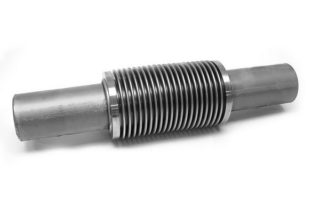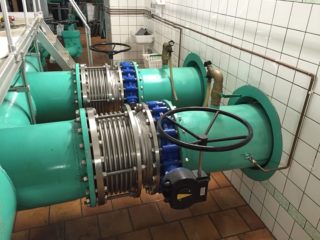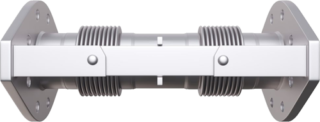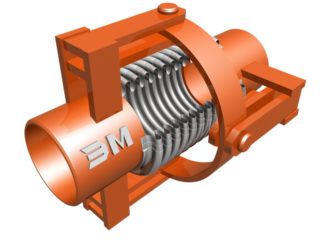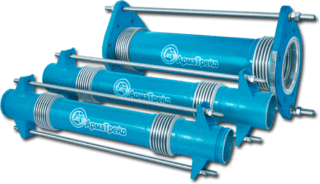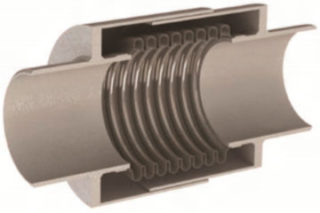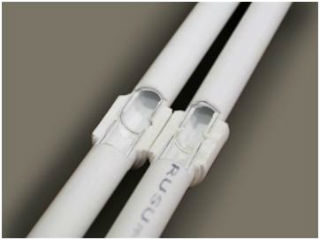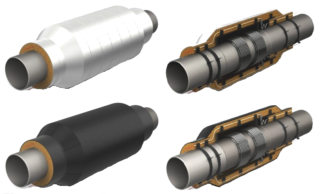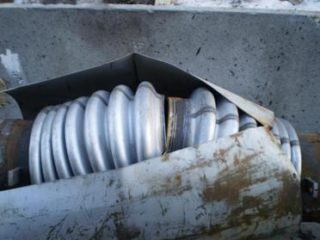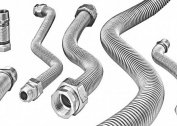Devices for compensating expansion prevent the destruction of circuits when heating heating mains. The bellows expansion joint for steel pipes balances misalignment in the system due to improper installation, reduces the stress on the operation of the units and the movement of flows. The bellows is a corrugated springy capsule of a single or multi-layer structure of metals, non-metals or composite materials.
The principle of operation of the bellows expansion joint
Stresses arise in the pipeline, the heating compensator counteracts deformation due to the elastic shell. The contours fail due to axial shear and rotation loads, depending on which certain types of discharge inserts are used.
Devices must be installed on systems:
- heating mains under pressure;
- closed feed and return circuits;
- pipelines for pumping gases and liquids.
Bellows installations reliably connect sections of the heating main, if correctly selected and mounted. Designs dampen vibration with small and large amplitudes, while the amplitude of the oscillations should not exceed 10% of the total shifts of the compensator.
Universal or balanced inserts are used if typical devices do not meet the requirements or there is a risk of pressure surges in excess of acceptable values in the network.
Specifications
Bellows are manufactured using rolled steel with a thickness of 0.3 - 0.5 mm. The batch at the outlet is checked for resistance to corrosion from chlorine at a temperature of + 150 ° C. Tightness is tested by hydrostatic compression using bubbles of nitrogen, air or helium. In expansion joints, tensile, leakage of the control substance and a decrease in pressure are not allowed.
The devices are tested for resistance to heat by raising the temperature to + 270 ° C and holding under these conditions for at least 1 hour. Checks for internal tearing, swelling, and delamination. The rigidity test is carried out by compressing and stretching the sample, the value must comply with GOST 286. 1997.
The longitudinal seams of the shells during manufacture are performed by welding at the same distance from one another. Metal bellows are produced by molding with calibration of corrugations. Small-diameter devices are made by hydraulic pressing.
Main dimensions
Applied visual and instrumental inspection to determine the appearance. Visually establishes the presence of a coating against corrosion on the pipes and bellows, marking. There should be no damage, dents, drops of solidified metal on the case. The compensator for polypropylene heating pipes should not have bundles of different sizes at the ends of the pipe.
Using the measurement, check the parameters:
- bore size;
- working length of the device;
- wall thickness and inner diameter of cutting flanges for welding;
- perpendicularity of an axis of a branch pipe to an end face of a cut.
The diameters and lengths of the bellows inserts are determined depending on the installation location, operating parameters of the heating main and the power of the heating equipment. Engineers carry out a technical calculation and choose the dimensions of the device in accordance with the norm.
Varieties of compensators
The design of the compensator determines the purpose of the product and its displacement during operation.Devices are released without thermal and waterproofing, or preliminary protection is provided on the housing, depending on the type of heating main (air or underground).
The manufacturer makes the types of expansion inserts:
- axial;
- flanged;
- angular;
- gimbal;
- shear;
- starting.
Unloaded compensators are used in the heating main to prevent spacer loading, seismic types are used in areas of alleged earthquakes. External pressure devices are installed in highways when there is a high pressure of a liquid or gas in the environment or there is a lack of it.
Designs differ in length and diameter, the number of bellows and the type of steel, the size and grade of metal pipes. Products work on rotation, tension, bending, compression, are available with or without connecting flanges.
Axial
CSR expansion joints for pipelines reduce the axial shift of the pipeline, reduce vibration and prevent damage from expansion when heated. Efficiency depends on the number of bellows and rings. The difference from other types is in the threaded connection with the pipe nozzles.
Axial compensators differ in characteristics:
- passage size 15 - 100 mm;
- withstands a pressure of 16 bar;
- size along the length - 260 mm;
- allows movement along the axis for compression up to 30 mm, for expansion - 20 mm;
- axial stiffness parameter - 30 - 89 kg / mm.
The movement limiter and pipe are made of galvanized metal, the bellows and the inner screen are made of stainless steel. Steel is used for the protective casing, the device is produced in a single section and is designed for an energy carrier temperature of up to + 90 ° С.
Flange
This type of bellows is made of rubber or rubber, heat-resistant metal is the raw material for flanges, and the cord is made of durable fabric. Flanged mounting greatly simplifies product installation. Compensators are used in a chemically active environment, are used in heat supply and air conditioning, are installed during the reconstruction and repair of boiler equipment.
Flange structures reduce vibration, reduce temperature shifts along the length, and compensate for deviations from the central axis of the pipeline.
Main parameters:
- nominal diameter - 32 - 800 mm;
- withstand the temperature of the energy carrier -10 - + 135 ° C;
- work with a pressure of 16 bar.
Flanges are free and solid in structure, attached to the pipe elements with studs, bolts with washers and nuts. Paronite gaskets are used, sometimes steel ones are made of thermally expanding granite or fluoroplastic.
Angular
PCB (rotary) is set in case of limited space, when it is possible to compensate only for axial displacement and contour rotation without changing in the plane. Contains a bellows, a guide element and fasteners. The device provides for the shift of the pipe along the selected angle, for this there are hinged or cardan stops.
Characteristics of rotary (angular) compensators:
- bushing nominal diameter - 15 - 1600 mm;
- maximum pressure - 1.6 - 4 MPa;
- axis movement - 24 - 200 mm;
- steel screen and protective box;
- bellows material - stainless steel;
- available with one or two sections;
- works with an energy carrier heated to +85 - + 150 ° С.
Corner structures are used as part of the heating main and for pumping oil and gas, and are used in the chemical industry.
Cardan
The bellows expansion joints balance the movement of the circuit in different planes, thanks to the hinged elements, bend in the direction of the central axis. The displacement of the highway is compensated along the axes X, Y, Z and in terms of rotation due to shrinkage, vibration. The flexible design provides for deformation in rigid contours.
Specifications:
- are designed, calculated and manufactured in accordance with the EJMA standard;
- contain 2 bellows with cardan type joints in the structure;
- shifted sideways by a distance multiple of 100 mm (100, 200, 300, 400), other sizes of the shifts are ordered separately;
- bushing nominal diameter - 25 - 1000 mm;
- works with energy carrier temperatures -190 - + 850 ° С.
The bellows is made of stainless steel, connectors, pipes made of chrome steel. It is put in the design position by welding or using a rotary flange. Used in any piping system.
Shear
KSSO compensators balance the shift due to longitudinal compression or lengthening of the circuit under the influence of temperature, eliminate the consequences of misalignment. The design has a corrugated capsule, a guide piece and fasteners. Using guide pins, longitudinal displacement is coordinated.
Parameters of shear compensating devices:
- nominal diameter of the passage - 32 - 500 mm;
- maximum pressure 0.6 - 4 MPa;
- bellows, couplers and nozzle are made of stainless steel;
- shield material selected by customer;
- withstands the temperature of the energy carrier up to + 850 ° C.
Shear devices are one and two-section, used to compensate for the stress in the pipelines of oil, water, steam, gas. Used in various industrial sectors and in energy complexes.
Starting
The CCM compensator is used temporarily as a one-time device when starting a heating main or hot water pipeline.
Technical specifications:
- nominal diameter Du through passage - 50 - 100 mm;
- shift along the central axis - 80 - 175 mm;
- the rigidity of the device at the level of 430 - 2300 N / mm;
- transports water up to + 150 ° С, steam - 250 ° С;
- allows a water flow rate of up to 5 m / s, steam - 65 m / s;
- the normalized pressure at the start of the line should not exceed 1.5 MPa.
The starting compensator is used when laying the circuit by the non-channel method. The material of the body, pipes and bellows is selected by the customer.
Installing a bellows expansion joint
The reference points for the compensators insert are the locations of the supports when the trunk is divided into sections and the position is predetermined. Supporting elements are verified using a level in three axes to ensure the correct operation of the heating main. Pipes on supports should slide without additional friction; for this, clamps with fluoroplastic gaskets are used.
Estimated installation points:
- behind the thermal support;
- behind supports from bends and deflections;
- between the sliding supports.
The energy path is taken into account when installing expansion joints with protective inner sleeves. Guide elements prevent the pipe from moving along a tangent line. The diameter DN in millimeters, the working pressure and the ability to balance shifts are taken into account. The diameter should correspond to a similar parameter of the heating main.
Pipe spacing
The main is divided into sections if one bellows structure is not enough to balance the shifts or there are branches on the heating main. The length of the segment should not be more than one compensator can cover. The device on the site is selected in accordance with the operating conditions and technical specifications. A description of the compensator model is given in the working documentation for the heating system.
Typically, the bellows device cuts at a distance of two nominal diameters from the retaining part. If it is placed between the supports, the distance to the supporting elements is selected 4 DN. Such dimensions prevent bending of the pipeline and reduce it to a minimum.
If several polypropylene loops are placed in parallel, it is taken into account that the diameter of the compensator slightly exceeds the diameter of the pipe. In this case, the bellows structures are staggered, and the distance between the pipes does not increase and is done according to the standards of the technical passport of the heating main.
Proper operation
Compensating inserts are thermally insulated with polyurethane foam if the line is protected from heat loss. Mandatory isolation from leaks is carried out.
Materials for waterproofing:
- polyethylene - with a closed installation in underground conditions;
- galvanizing - for thermal communications arranged in an open way.
The insulation is placed taking into account the possible displacement of the casing during expansion or contraction of the pipeline. Thermal protection is checked and repaired from time to time along with insulation of the trunk.
Safety standards
The service life of the compensators is provided for 30 years, while the device can be stored in the warehouse for no more than 5 years before starting work.
Within the service life, the following loads are allowed:
- compression-tension from minimum to maximum - 10 cycles;
- reduction or elongation of 70% of the maximum and minimum limit - 150 cycles;
- shifts within 20% of the stroke - 10 thousand cycles.
Bellows expansion joints must be certified by the manufacturer to certify compliance. Certified materials are used for welding, installation is performed by certified workers. It is forbidden to use designs in conditions exceeding permissible. It is impossible to use compensators as supports during the installation of the heating main.
